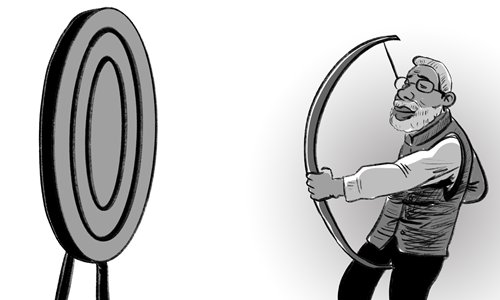HOME >> BUSINESS
India’s $5t goal requires more successful reforms
By Hu Bofeng Source:Global Times Published: 2019/7/11 17:09:14

Illustration: Luo Xuan/GT
When addressing the fifth meeting of the Governing Council of Niti Aayog last month, Indian Prime Minister Narendra Modi said that the goal to make India a $5 trillion economy by 2024 is challenging, but achievable. Objectively speaking, achieving this goal will be difficult.
The size of the Indian economy is currently around $2.8 trillion, so the $5 trillion target means that the economy will have to almost double its current size in the next five years. Or, to put it another way, from now on, India's economic growth needs to maintain an annual rate of more than 10 percent every year to achieve the goal of reaching $5 trillion by 2024. India's current GDP growth rate is merely 6 percent, however, thus the gap is obvious.
According to the development path designed by the Indian government, various states must fully recognize and enhance their respective core competitiveness to realize the target of $5 trillion. Moreover, the government aims to double farmers' incomes by 2022 through structural reform in agriculture, with a focus on fisheries, animal husbandry, horticulture and cultivation of fruit and vegetables. Also, the country's exports will be further strengthened.
Nevertheless, these policies have encountered difficulties during the implementation process, making it hard for them to be the fundamental solution to boost India's development. It is known to all that problems with its "tax, land and people" have always been considered to be the three key factors constraining India's economic development. Since the 1990s, successive Indian governments have realized that without changes to its tax system, land and labor issues, the country could hardly see a real economic take-off. However, due to some political resistance, most of the reforms in these aspects have failed.
On July 1, 2017, India rolled out the Goods and Services Tax (GST), the country's biggest tax reform since Independence. Although there are still problems with taxation and collection, it is undeniable that the GST has been effective in terms of unifying the country's tax system and promoting circulation of goods. However, due to various reasons, land reform and labor reform failed to see any breakthrough during Modi's first term.
What kind of impact has the land problem had on India's economic growth? Take the high-profile Mumbai-Ahmedabad high-speed rail project as an example. Because of the land acquisition problem, construction of the project has been delayed. According to media reports, land acquisition should have been finished by the end of 2018, but only about one-third of the land has been acquired so far. The inefficiency of India's land acquisition policy will inevitably drag on its economic development and is a big problem for the Modi government.
India has a huge demographic dividend, especially in terms of its youth labor force. If labor reforms cannot be
carried through, the dividend will not be realized, making it difficult to achieve the long-term goal of manufacturing transformation. The labor reform issue is complicated and sensitive, with big differences over the direction and focus of the reform among the government, labor union and academic circles. In this sense, it will be hard for various parties to reach a consensus in the short term.
As to the external environment, the US protectionist policies have also posed risks and challenges for India. On June 5, the US officially ended preferential trade treatment of India, which was followed by India's retaliatory tariffs on 28 US products starting from June 16.
In terms of market access, the US takes an even more aggressive attitude toward India. Senior US officials have been calling for greater efforts from India to reduce or eliminate tariff and non-tariff barriers to further open the market to the US. The US was even reportedly considering caps on H1B work visas, which would severely hit India's technology sector.
While Modi and Trump reached a consensus on pushing to resolve trade disputes during the G20 Osaka meeting, India is unlikely to give the US whatever it wants. Frictions may only be suppressed temporarily.
China has always been committed to establishing deeper economic cooperation and developing closer economic ties with India. As members of the BRICS countries, the economic relationship between China and India is not a "zero-sum game." We would like to see the rise of another economic power in Asia. If the internal and external conditions could be continuously improved, an India that is able to achieve the $5 trillion goal would bring more economic vitality and impetus to Asia and the world.
The author is an India-based commentator. bizopinion@globaltimes.com.cn
Posted in: INSIDER'S EYE